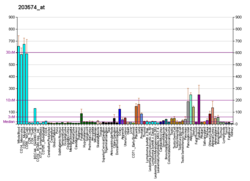| NFIL3 |
|---|
|
| Identifiers |
|---|
| Aliases | NFIL3, E4BP4, IL3BP1, NF-IL3A, NFIL3A, nuclear factor, interleukin 3 regulated |
|---|
| External IDs | OMIM: 605327 MGI: 109495 HomoloGene: 3928 GeneCards: NFIL3 |
|---|
| Gene location (Human) |
|---|
 | | Chr. | Chromosome 9 (human)[1] |
|---|
| | Band | 9q22.31 | Start | 91,409,045 bp[1] |
|---|
| End | 91,423,832 bp[1] |
|---|
|
| Gene location (Mouse) |
|---|
 | | Chr. | Chromosome 13 (mouse)[2] |
|---|
| | Band | 13 B1|13 27.68 cM | Start | 53,121,245 bp[2] |
|---|
| End | 53,135,109 bp[2] |
|---|
|
| RNA expression pattern |
|---|
| Bgee | | Human | Mouse (ortholog) |
|---|
| Top expressed in | - vena cava
- pericardium
- gastric mucosa
- left uterine tube
- popliteal artery
- stromal cell of endometrium
- periodontal fiber
- right ventricle
- canal of the cervix
- gastrocnemius muscle
|
| | Top expressed in | - secondary oocyte
- digastric muscle
- left lobe of liver
- plantaris muscle
- sternocleidomastoid muscle
- triceps brachii muscle
- lip
- thoracic diaphragm
- extensor digitorum longus muscle
- islet of Langerhans
|
| | More reference expression data |
|
|---|
| BioGPS |  | | More reference expression data |
|
|---|
|
| Gene ontology |
|---|
| Molecular function | - DNA-binding transcription factor activity
- DNA binding
- DNA-binding transcription repressor activity, RNA polymerase II-specific
- RNA polymerase II transcription regulatory region sequence-specific DNA binding
- protein binding
- transcription corepressor activity
- RNA polymerase II cis-regulatory region sequence-specific DNA binding
- DNA-binding transcription factor activity, RNA polymerase II-specific
- identical protein binding
| | Cellular component | | | Biological process | - cellular response to interleukin-4
- positive regulation of gene expression
- regulation of transcription, DNA-templated
- negative regulation of transcription by RNA polymerase II
- transcription by RNA polymerase II
- circadian rhythm
- immune response
- transcription, DNA-templated
- rhythmic process
- negative regulation of transcription, DNA-templated
- positive regulation of transcription, DNA-templated
| | Sources:Amigo / QuickGO |
|
| Orthologs |
|---|
| Species | Human | Mouse |
|---|
| Entrez | | |
|---|
| Ensembl | | |
|---|
| UniProt | | |
|---|
| RefSeq (mRNA) | |
|---|
NM_005384
NM_001289999
NM_001290000 |
| |
|---|
| RefSeq (protein) | |
|---|
NP_001276928
NP_001276929
NP_005375 |
| |
|---|
| Location (UCSC) | Chr 9: 91.41 – 91.42 Mb | Chr 13: 53.12 – 53.14 Mb |
|---|
| PubMed search | [3] | [4] |
|---|
|
| Wikidata |
| View/Edit Human | View/Edit Mouse |
|



















